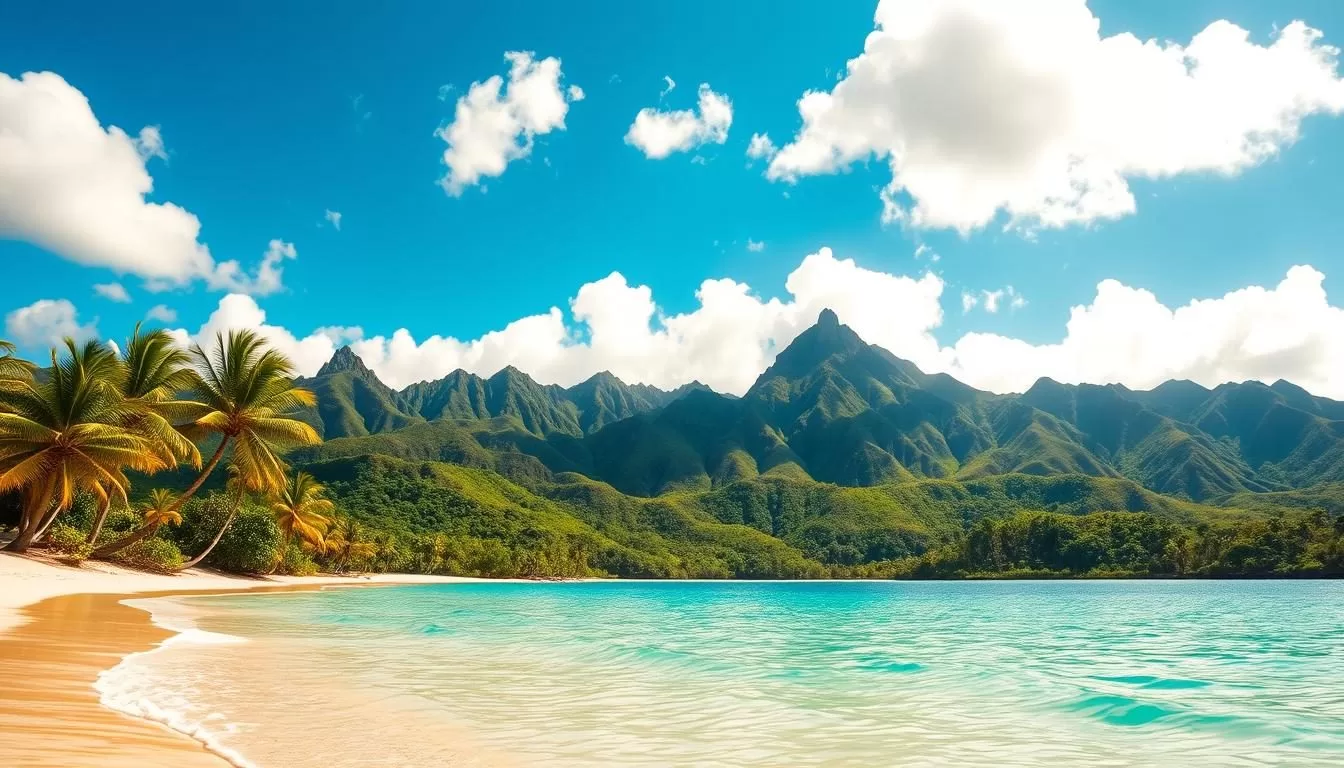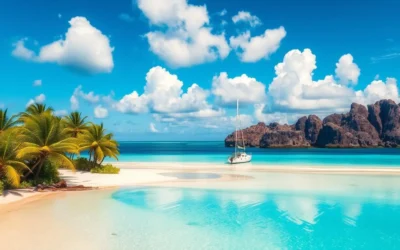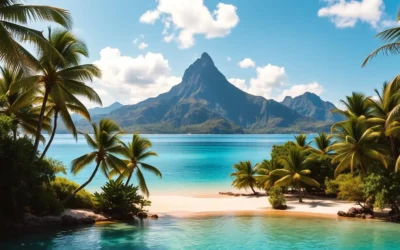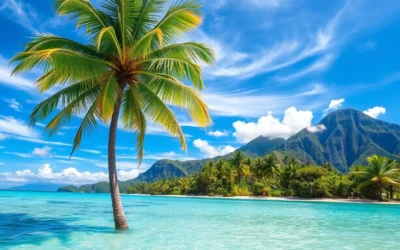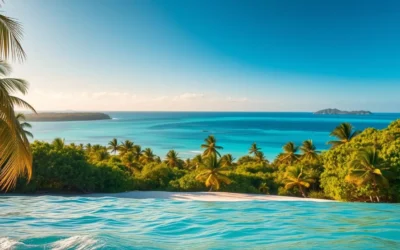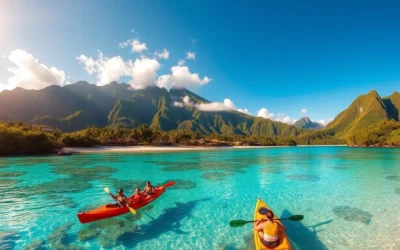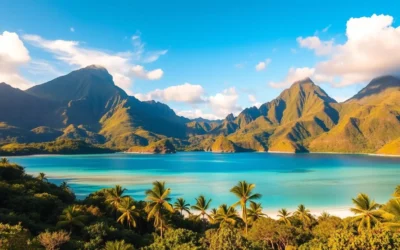Are you planning a tropical getaway to the stunning islands of French Polynesia? This breathtaking French overseas territory, comprising five archipelagos, offers an unforgettable experience with its warm climate, crystal-clear waters, and gentle trade winds. Spanning an area as vast as Europe, The Islands of Tahiti are perfect for travelers seeking to explore, relax, or indulge in water activities.
Understanding the unique weather patterns is crucial for a well-planned trip. The archipelagos experience a tropical climate with distinct wet and dry seasons, each offering advantages for different travelers. Your ideal time to visit depends on your priorities – whether you’re seeking the best weather, lower prices, or specific activities.
With several island groups like Tahiti, Bora Bora, and Moorea, each having slight climate variations, this guide will help you navigate the weather to plan a trip that aligns with your preferences.
Understanding French Polynesia’s Climate
The islands of French Polynesia boast a tropical paradise climate, characterized by warm temperatures and distinct seasonal variations. This climate makes French Polynesia an attractive destination for travelers seeking a warm and sunny getaway.
Tropical Paradise Year-Round
French Polynesia enjoys a tropical climate that remains relatively consistent throughout the year, with temperatures typically ranging from 70°F to 95°F (21°C to 35°C) depending on the season. The islands experience minimal temperature fluctuations throughout the year, but the significant differences in rainfall, humidity, and wind patterns create two clearly defined seasons. The tropical climate creates lush, verdant landscapes across the islands, with the varying rainfall between seasons affecting everything from water clarity for diving to the vibrancy of the jungle vegetation.
The Two Distinct Seasons
The climate in French Polynesia is characterized by two distinct seasons: the dry season from May to October, and the wet season from November to April. The dry season offers sunny days, lower humidity, and light breezes, making it ideal for outdoor activities. In contrast, the wet season brings tropical showers and higher humidity, nourishing the lush landscapes and creating a vibrant green environment. Understanding these seasonal variations is crucial for planning your trip to French Polynesia.
The Dry Season: May to October
French Polynesia’s dry season, which takes place from May to October, offers the best time to enjoy the islands’ natural beauty. During this period, the weather is characterized by mild temperatures and lower humidity, making it ideal for outdoor activities and exploring the islands.
Weather Patterns and Temperatures
The dry season is marked by comfortable temperatures ranging from 70°F to 80°F (21°C to 27°C). These pleasant conditions, combined with minimal rainfall, create an ideal environment for enjoying the pristine beaches, crystal-clear lagoons, and scenic hiking trails that French Polynesia is known for.
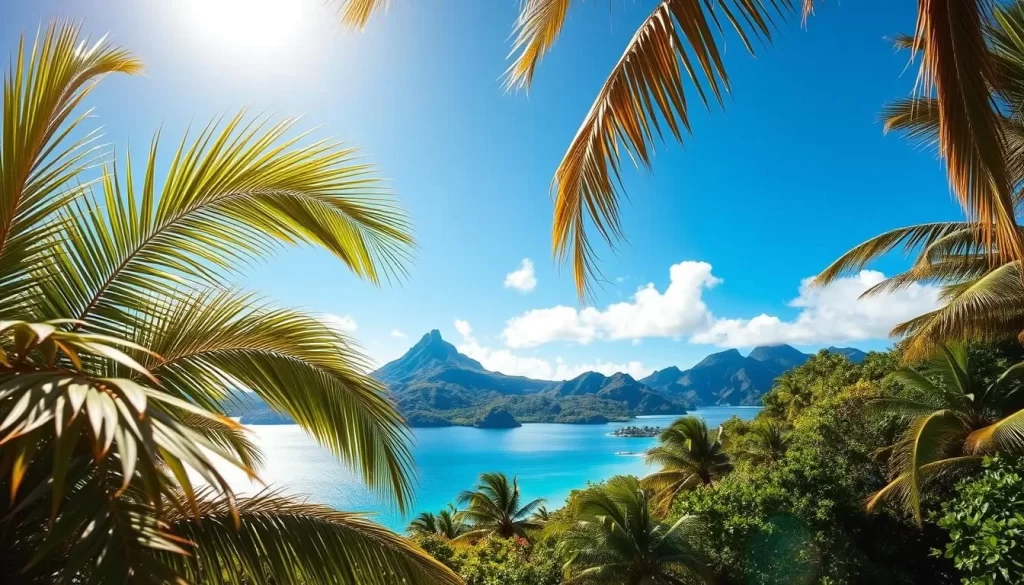
Advantages of Visiting During This Period
Visiting French Polynesia during the dry season has several advantages. The calm seas and clear waters offer exceptional visibility for snorkeling and diving, allowing you to explore the vibrant coral reefs and marine life. The dry season is also perfect for water sports and other outdoor activities, making it a great time to experience all that the islands have to offer.
Potential Drawbacks: Crowds and Prices
While the dry season is the best time to visit in terms of weather, it’s also the peak tourist season. You can expect to encounter more crowds at popular destinations like Bora Bora and Moorea. Additionally, the months of July and August see the highest visitor numbers, which can lead to higher prices. Considering the shoulder months of May and October can help you strike a balance between good weather and more reasonable prices.
The Wet Season: November to April
The wet season in French Polynesia, spanning from November to April, is characterized by warm temperatures and increased rainfall. This period is ideal for travelers seeking a tropical getaway during Europe’s winter season.
What to Expect: Rainfall and Humidity
During the wet season, you can expect more frequent rainfall, particularly in December, January, and February. The tropical showers are typically brief, often followed by clear skies and plenty of sunshine. The increased rainfall creates lush, vibrant landscapes with waterfalls reaching their peak flow and vegetation at its most verdant and colorful.
Benefits of Low Season Travel
One of the major benefits of traveling during the wet season is the significant reduction in tourist numbers, resulting in more secluded beaches and easier reservations at top restaurants. You can also enjoy a more authentic island experience. Moreover, accommodation prices can drop by 30-40% during this period, making it an excellent option for budget-conscious travelers looking to experience luxury resorts at more affordable rates.
Tips for Dealing with Tropical Showers
To make the most of your wet season visit, plan indoor activities or spa treatments during the typical afternoon shower times, and keep flexible with outdoor excursions. Be sure to pack light, quick-drying clothing, a quality rain jacket, and waterproof bags for electronics to ensure that tropical showers don’t disrupt your plans.
French Polynesia: Best Months for a Weather-Savvy Trip
When planning a trip to French Polynesia, timing is everything, and understanding the best months to visit can make all the difference. The islands offer a tropical paradise experience year-round, but certain periods are more conducive to an ideal vacation.
May and September: The Sweet Spots
For travelers seeking a balance between favorable weather and manageable crowds, May and September stand out as the sweet spots. These shoulder months provide the advantages of the dry season, including pleasant weather, with the added benefits of lower tourist numbers and more competitive pricing compared to the peak months.
June to August: Peak Weather Conditions
The period from June to August is characterized by the driest climate and balmy weather, making it the peak season for visiting French Polynesia. Temperatures are comfortably in the high 70s to mid-80s Fahrenheit, and the water clarity is exceptional, ideal for underwater activities.
Here’s a summary of the best times to visit French Polynesia:
| Month | Weather Conditions | Crowd Levels | Prices |
|---|---|---|---|
| May & September | Favorable | Moderate | Competitive |
| June to August | Peak dry season | High | Premium |

Considering the full moon can also enhance your trip, as the islands take on a magical quality under the moonlight. For photographers, the dry season, particularly the early morning hours, offers the best opportunity to capture the famous overwater bungalows against clear blue skies.
Island-Specific Weather Considerations
When planning your trip to French Polynesia, it’s essential to consider the unique weather patterns of each island group. The archipelagos that make up French Polynesia offer diverse climates, making some islands more suitable to visit at certain times of the year than others.
Society Islands: Tahiti, Bora Bora, and Moorea
The Society Islands, including Bora Bora and Moorea, are known for their predictable weather patterns, with a clear distinction between the wet and dry seasons. The dry season, from May to October, is the best time to visit these islands, offering pleasant temperatures and clear skies that showcase their stunning turquoise waters to perfection.
Tuamotu Atolls
The Tuamotu Atolls, such as Rangiroa and Fakarava, have a relatively dry climate year-round compared to the Society Islands. For diving enthusiasts, the best time to visit is from April to November, when water visibility is exceptional and marine life is abundant in the famous passes.
Marquesas, Australes, and Gambier Islands
The Marquesas Islands have a different weather pattern, with their driest period occurring from September to December, making this the ideal time for exploring their dramatic landscapes. The remote Australes and Gambier Islands experience cooler temperatures, with July to October offering the most pleasant conditions for visitors.
Understanding these weather variations across the different island groups will help you plan a more enjoyable and tailored trip to French Polynesia.
Seasonal Activities and Experiences
As you plan your trip to French Polynesia, understanding the seasonal activities can help you make the most of your travel experience. The islands offer a range of activities that cater to different interests and preferences, depending on the time of year you visit.
Dry Season Adventures
During the dry season, from May to October, you can enjoy optimal conditions for hiking the volcanic peaks of Moorea and Tahiti. Trails like Mount Rotui and Mount Aorai offer spectacular panoramic views under clear skies. Water activities also reach their peak during this period, with exceptional visibility for snorkeling and diving, calm seas for paddleboarding and kayaking, and perfect conditions for lagoon excursions.
| Activity | Location | Best Time |
|---|---|---|
| Hiking | Moorea, Tahiti | Dry Season |
| Snorkeling/Diving | Rangiroa, Fakarava | Dry Season |
| Sailing/Island-Hopping | Various Islands | Dry Season |
Wet Season Opportunities
The wet season, from November to April, brings its own unique activities. Surfing at Teahupo’o on Tahiti is a highlight, with the best waves during this period, making it a popular spot for surfers worldwide. Waterfall enthusiasts will also enjoy the increased flow rates at Fautaua Waterfall and the three waterfalls of Faarumai.
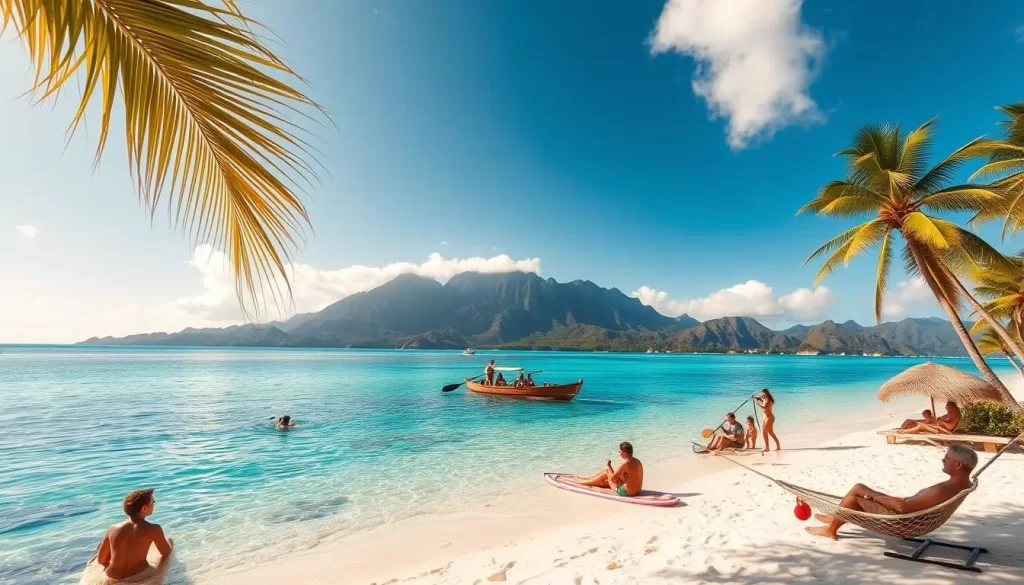
Marine Life and Water Activities by Season
Diving into the crystal-clear waters of French Polynesia reveals a vibrant world of marine life, changing with the seasons. The islands offer a diverse range of underwater experiences, from snorkeling with manta rays to watching humpback whales migrate through the area.
Best Times for Diving and Snorkeling
The dry season, from May to October, is considered the best time for scuba diving and snorkeling in French Polynesia. During this period, the water clarity often exceeds 100 feet, providing breathtaking visibility of the coral reefs and diverse marine life. Locations like Rangiroa and Fakarava are renowned for their exceptional diving experiences, with the chance to see manta rays and sharks.
| Location | Best Time | Notable Marine Life |
|---|---|---|
| Rangiroa | Dry Season (May-Oct) | Manta Rays, Sharks |
| Fakarava | Jan-Mar | Sharks, Coral Spawning |
| Bora Bora | Year-Round | Manta Rays, Blacktip Reef Sharks |
Whale Watching Season
For those interested in whale watching, French Polynesia is a prime destination between August and November. During this time, humpback whales migrate to the warm waters to mate and give birth, offering spectacular opportunities to observe these majestic creatures up close on guided tours.
Cultural Events and Festivals Throughout the Year
French Polynesia’s cultural scene is alive with festivities, offering travelers a chance to immerse themselves in local traditions. The islands host a variety of cultural events and festivals throughout the year, making any month a great time to experience the rich Polynesian heritage.
Heiva i Tahiti and Summer Celebrations
In July, the Heiva i Tahiti festival takes center stage, showcasing traditional Polynesian dance, sports, and artistic exhibitions. This month-long celebration is a highlight of the cultural calendar, providing a unique insight into Polynesian culture.
- Traditional dance competitions
- Sports contests
- Artistic exhibitions
Chinese New Year and Other Cultural Festivities
The French Polynesian Chinese community celebrates the New Year in January or February with parades, dragon dances, and festive markets. Additionally, the Ori Tahiti Festival in April focuses on traditional Polynesian dance, while the Marquesas Arts Festival (Matavaa) occurs every four years in December.
- Chinese New Year celebrations in Papeete, Tahiti
- Ori Tahiti Festival in April
- Marquesas Arts Festival (Matavaa) in December
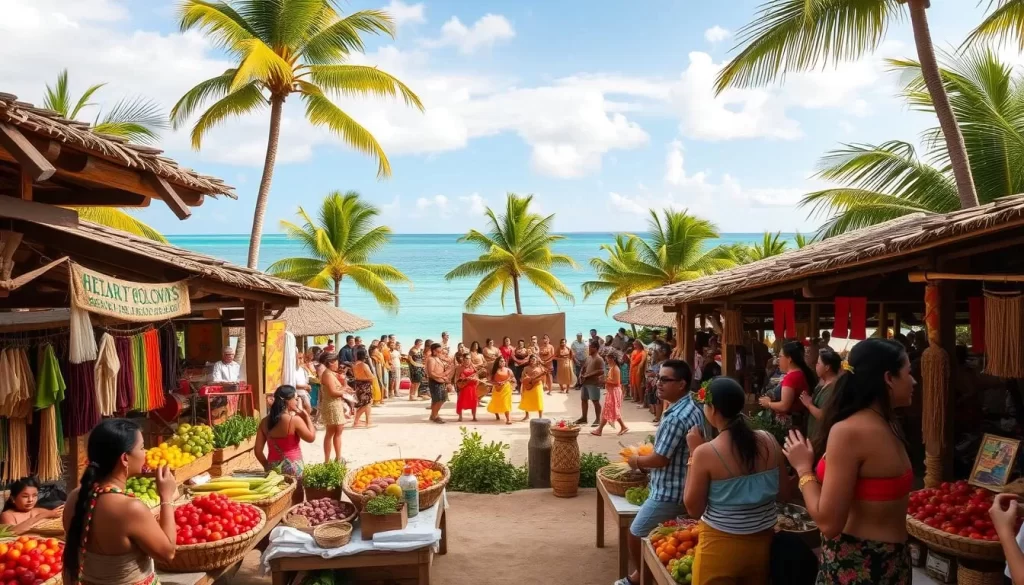
Budget Considerations: High vs. Low Season
Your wallet can be significantly impacted by the season you choose to visit French Polynesia, so it’s worth considering. The cost of your trip can vary greatly depending on whether you travel during the high or low season.
Price Variations Throughout the Year
During the high season, which runs from June to September, prices for hotels and resorts can increase by 30-50%. Luxury accommodations, such as overwater bungalows in Bora Bora, can command rates exceeding $1,000 per night. In contrast, the low season, from November to April, offers lower hotel rates and fewer crowds.
Getting the Best Value for Your Trip
To get the best value for your trip, consider traveling during the shoulder months of May and October. Prices are typically 15-25% lower than peak season, while the weather remains favorable. You can also look out for package deals that combine flights, accommodations, and transfers, which often provide better value than booking components separately.
| Season | Prices | Weather |
|---|---|---|
| High Season (June-September) | Higher prices (30-50% increase) | Dry and sunny |
| Low Season (November-April) | Lower prices | Warmer with occasional rain showers |
| Shoulder Season (May, October) | Moderate prices (15-25% lower than peak) | Favorable weather |
By being mindful of the season and planning accordingly, you can make the most of your budget and enjoy a wonderful trip to French Polynesia.
Conclusion: Planning Your Weather-Perfect French Polynesian Getaway
Whether you’re drawn to the dry season’s sunny skies or the wet season’s lush landscapes, French Polynesia has something for everyone. The perfect time to visit French Polynesia ultimately depends on your priorities and preferences.
For a trip with perfect weather, consider the dry season from May to October. If you’re on a budget, the wet season (November-April) offers better value, making luxury experiences like staying in an overwater bungalow in Bora Bora more accessible. You can also plan your tour around specific natural phenomena or cultural events.
By choosing the right time for your trip, you can enjoy the diverse landscapes and experiences that French Polynesia has to offer, from the Society Islands to the Tuamotus. Booking with a travel specialist can help you craft the perfect itinerary tailored to your interests.
The above is subject to change.
Check back often to TRAVEL.COM for the latest travel tips and deals.
Here are some Tours & Sightseeing suggestions that might pique your interests!
